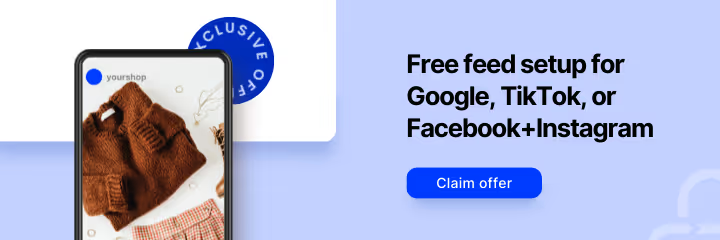5.1B people now have mobile phones and nearly half the world’s population uses social media.
It goes without saying, many of those people take part in online shopping as well. Globally, 1.9B people shop online, that includes 96% of the US.
That's a lot of people that are ready to shop at any given time and on any store or network. Listing your products on shopping engines and marketplaces is important, but you shouldn't stop there.
You need to meet your audience where they hang out. You need to show up on their social feeds.
Product marketing on social networks
To get the right products in front of the right people, you’ll need solid product data and a system that enables seamless ad creation from a product feed. These are known as dynamic product ads and they leverage advanced targeting techniques to make the most of your product catalog.
Dynamic product ads are unrelated to your general activity on a social network but being relevant on a network adds credibility if you end up producing ads on that channel (not to mention how great social relevance is for brand awareness).
Facebook
A bit over a fifth of the world’s population uses the platform on a daily basis — around 1.59B people; 2.41B on a monthly basis. In the US alone, over half of the population uses Facebook. This is the type of range you want for your ads.
Facebook offers a range of flexible advertising options. There’s virtually no limitation to where you can advertise on the network. However, for the purpose of product marketing, Facebook’s dynamic ads hit the nail right on the head.
Automated from your product data and personalized with the help of a tracking pixel, Facebook dynamic product ads automatically show relevant ads to people who have expressed interest on your website, in your app, or elsewhere on the internet. These ads can be delivered in the form of single image ads, carousel ads, or collection ads across the network.

Instagram
Instagram sees an average of 1B monthly active users, half of which use the platform daily. This makes it the second most engaged social network after its parent company, Facebook.
Consider the following: 71% of Instagram users are under the age of 35 – in the US alone, 72% of teens use the platform – 60% of users discover products on the Gram, and 75% of users engage with posts. Couple that with the fact that Instagrammers are 70% more likely to buy via mobile, and that Gen Z has some serious purchasing power… and you have a wild recipe for marketing potential that is unique to Instagram.
From a product marketing — as well as a general advertising perspective — Instagram and Facebook complement each other very nicely. Not just because they’re the top 2 social networking sites and they cover a wide range of demographics together, but also because they use the same ads manager.

Pinterest
As of the first quarter of 2019, Pinterest reported 291M monthly active users (over a third of which are US users). 79.5% of these users are female, but the male audience share has increased over time. This demographic split is extra significant though, as women drive 70-80% of the buying decisions in the US.
Additionally, around 50% of millennials use Pinterest every month, 47% of which purchase something they interact with. This portion of the audience is incredibly valuable, as millennials tend to research products on social before buying. It’s no secret that users love to shop on Pinterest. 90% of Pinners said they make purchase decisions on the platform, and 70% use it to find new products.
According to Pinterest, users see the platform as a valuable part of their purchasing journey; they plan ideas, catalog inspiration, and visualize goals on Pinterest. Brands can leverage the platform to connect with their most interested and engaged audiences.
Any business can create a free business account and turn their product catalog into visual, actionable ads.

Snapchat
As of Q2 of 2019, Snapchat had approximately 203M daily active users, reaching 90% of all 13-24 year-olds and 75% of all 13-34 year-olds in the US. It’s a hit among teens and millennials, but sees a drop among those age 50 and above.
Although not explicitly amazing for product marketing like Facebook, Instagram, and Pinterest, Snapchat is notable because of its appeal to younger generations. 63% of Snapchat users in a Pew Research Center study cited that they use the app on a daily basis. Among them, 49% of them use the app several times a day.
According to Snapchat, these power users open their app over 20 times a day and spend an average of 30 minutes on the app creating over 3.5B Snaps daily. All of this points towards Snapchat being another unique social network with a highly active userbase.
With Snapchat Shoppable Ads, businesses can effectively advertise their products to this massive, active audience.

Honorable Mentions
The following social networks are honorable mentions because they don’t have any sort of integrated product marketing. Yet, they do have advertising options.
Typically, what matters most on these platforms is brand presence above all else. Although that’s not always the case. Let’s discuss.
As of the first quarter of 2019, Twitter had 330M global monthly active users and 126M daily users. Although small compared to the behemoth that is Facebook, Twitter has a special place in the grand scheme of social things.
Many B2C brands have turned to Twitter to provide customers with recommendations, troubleshoot issues, resolve grievances, and generally engage with their audiences. It’s become the platform to engage the masses before, during, and after an event. Twitter is great for extra relevance during sponsored events and essential for general communication.
Although void of explicit product marketing capabilities (they do have a fantastic ad platform though), you’ll want to be present on Twitter. Regardless of whether you’re present or not… people will talk about your brand here – it’d be best to have a part in the discussion.
Youtube
Next up, everyone’s favorite online video platform.
1B hours of YouTube content is watched per day. It’s the second most visited site in the world, attracting nearly ⅓ of the world on a monthly basis and 30M people daily.
The thing is, Youtube is a tricky mention here – many don’t see it as a social network and technically it does have product marketing integration via Google Shopping. Well, it is a social network, but we’re not going to count it is a social product marketing priority... yet.
First off, let’s address that “Is it a social network?” concern – Matt Rozen of Adobe said it best:
“Its (Youtube) core functionality beyond presenting videos to watch is to allow for social interactions. It’s the quintessential social video platform because it reaches so many people… Social is its differentiator.”
So that settles that… but we’re counting it out as a social product marketing priority, as it’s ad strength comes from video ads and regular display ads – not dynamic product marketing ads. That’s not to say Google isn’t a rockstar ad platform, because it definitely is.
Youtube just shouldn’t be at the top of your list if you’re trying to get into dynamic product marketing ads on social. That being said, dynamic ads will probably be making their way onto Youtube in the near future – Google has been further developing their Shopping Actions program to play more of a cohesive role across all of their services. As is, GSA has greatly impacted the way Google Shopping works, and there are plans to expand its features into Youtube.

Regardless, Youtube should be a massive priority overall if you: have a video content strategy, could make strong video ads, and/or you want in on being relevant everywhere.
TikTok
Lastly, we’ll be touching upon the viral sensation, TikTok.
Tiktok gets an honorable mention spot because it’s incredibly promising – As of June 2019, TikTok had over 500M monthly active users around the world (26M of them being in the US). What initially seemed like a quick fad has definitely evolved into a full-blown trend.
And although there’s no sign of dynamic product ads on the platform, the company has gotten creative with its advertising platform. There’s no doubt they will continue to innovate as the platform further cemets itself as an essential app.
If your audience is on TikTok and you can allocate resources to create your own channel (and relevant videos), work with influencers, and/or pay to advertise on TikTok, then that may work well in your favor.
You’ll want to focus on TikTok as a marketing medium if your strategy naturally involves making relevant content for the platform. Using TikTok for marketing purposes is similar to Snapchat – a forced presence won’t take you very far.
Final thoughts
Social marketing prioritizes brand awareness, while product marketing on social networks prioritizes conversions. Both work better together, but both need special attention.
When it comes to efficient product marketing on social networks: the importance of solid product data cannot be overstated, and advanced targeting plus the use of product feeds to automate ads is key.
Focus on building a strong presence on Facebook and Instagram, and strongly consider Pinterest and Snapchat. Overall though, you want to be relevant on as many social platforms as possible, but aim to produce genuinely useful content on your mission to social relevancy. People see through shallow content, it hurts your credibility overall.
Looking to expand to new channels? We can help.






%20).webp)